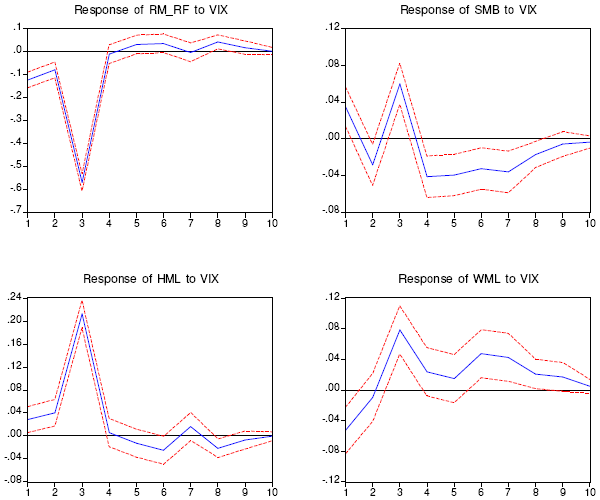In one of the financial markets alternate universes, anchored on the Fama-French three-factor model, the central explanatory theme is reward-for-risk derived from market (equity) premium , the value premium and the size effect. Within this model, each factor presents to investors an opportunity to boost mean return in exchange for bearing more violent variation of return. The Carhart four-factor model adds a momentum effect as an additional risk factor. Should implied market volatility (the “investor fear gauge”), as measured by such variables as the CBOE Volatility Index (VIX) be a fifth risk factor? In their February 2007 paper entitled “Fear and the Fama-French Factors”, Robert Durand, Dominic Lim and Kenton Zumwalt examine the case for adding investor expectations for overall market volatility (a “fear factor”) to establish a five-factor model of equity market behavior. Using daily data for the period 2/93-12/03, they find that:
- VIX alone is not helpful in explaining daily stock returns.
- In combination with the other four risk factors (equity premium, value premium, size effect and momentum effect), VIX does help explain daily stock returns. This result is robust for different sample subperiods.
- Changes in VIX cause changes in the other four risk factors, especially the equity premium and the value premium. And, changes in the equity and value premiums cause changes in VIX.
- However, even a five-factor model appears to be incomplete in that it fails to explain residual January and day-of-the-week effects.
The following charts, taken from the paper, show the effects of a VIX shock on the other four factors (equity premium, value premium, size effect and momentum effect) over a period of a few days. The solid blue lines map the effects, with the dashed red lines bracketing a confidence interval of one standard error above and below. The charts show that an increase in VIX is associated with:
- A sharp decrease in the equity risk premium (RM_RF), consistent with a negative relationship between the market and expected volatility.
A sharp increase in the value premium (HML), consistent with investors flying to value stocks from growth stocks. - An increase in the momentum effect (WML), consistent with investors moving to proven winners.
- A mixed initial effect but ultimate (after four days) decrease in the size premium (SMB), consistent with investors shifting to large capitalization stocks.

In summary, implied or expected volatility (VIX) should tentatively be viewed as a fifth factor in modeling stock returns because it affects them both directly in a multi-factor model and indirectly through the other risk factors.
Five is not enough? Critics of the reward-for-risk model might accuse it of becoming a Rube Goldberg contraption.